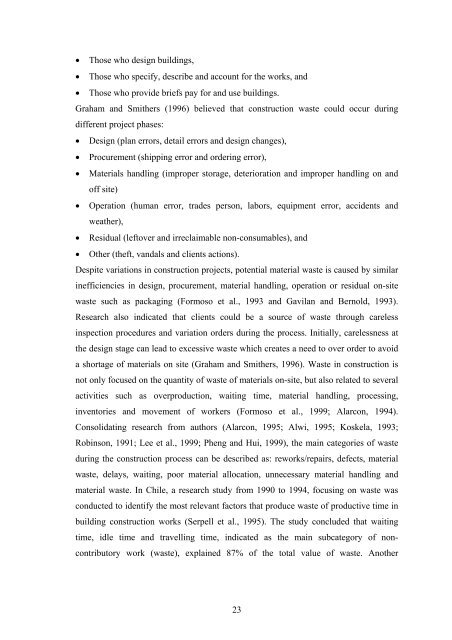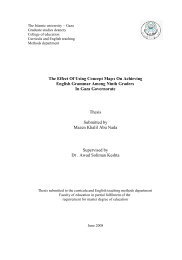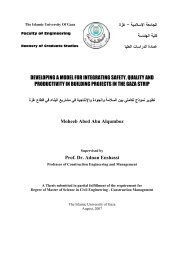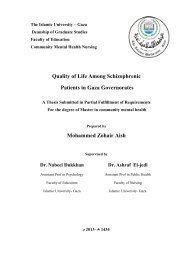A Study of Lean Construction Practices in Gaza Strip
A Study of Lean Construction Practices in Gaza Strip
A Study of Lean Construction Practices in Gaza Strip
Create successful ePaper yourself
Turn your PDF publications into a flip-book with our unique Google optimized e-Paper software.
• Those who design build<strong>in</strong>gs,<br />
• Those who specify, describe and account for the works, and<br />
• Those who provide briefs pay for and use build<strong>in</strong>gs.<br />
Graham and Smithers (1996) believed that construction waste could occur dur<strong>in</strong>g<br />
different project phases:<br />
• Design (plan errors, detail errors and design changes),<br />
• Procurement (shipp<strong>in</strong>g error and order<strong>in</strong>g error),<br />
• Materials handl<strong>in</strong>g (improper storage, deterioration and improper handl<strong>in</strong>g on and<br />
<strong>of</strong>f site)<br />
• Operation (human error, trades person, labors, equipment error, accidents and<br />
weather),<br />
• Residual (leftover and irreclaimable non-consumables), and<br />
• Other (theft, vandals and clients actions).<br />
Despite variations <strong>in</strong> construction projects, potential material waste is caused by similar<br />
<strong>in</strong>efficiencies <strong>in</strong> design, procurement, material handl<strong>in</strong>g, operation or residual on-site<br />
waste such as packag<strong>in</strong>g (Formoso et al., 1993 and Gavilan and Bernold, 1993).<br />
Research also <strong>in</strong>dicated that clients could be a source <strong>of</strong> waste through careless<br />
<strong>in</strong>spection procedures and variation orders dur<strong>in</strong>g the process. Initially, carelessness at<br />
the design stage can lead to excessive waste which creates a need to over order to avoid<br />
a shortage <strong>of</strong> materials on site (Graham and Smithers, 1996). Waste <strong>in</strong> construction is<br />
not only focused on the quantity <strong>of</strong> waste <strong>of</strong> materials on-site, but also related to several<br />
activities such as overproduction, wait<strong>in</strong>g time, material handl<strong>in</strong>g, process<strong>in</strong>g,<br />
<strong>in</strong>ventories and movement <strong>of</strong> workers (Formoso et al., 1999; Alarcon, 1994).<br />
Consolidat<strong>in</strong>g research from authors (Alarcon, 1995; Alwi, 1995; Koskela, 1993;<br />
Rob<strong>in</strong>son, 1991; Lee et al., 1999; Pheng and Hui, 1999), the ma<strong>in</strong> categories <strong>of</strong> waste<br />
dur<strong>in</strong>g the construction process can be described as: reworks/repairs, defects, material<br />
waste, delays, wait<strong>in</strong>g, poor material allocation, unnecessary material handl<strong>in</strong>g and<br />
material waste. In Chile, a research study from 1990 to 1994, focus<strong>in</strong>g on waste was<br />
conducted to identify the most relevant factors that produce waste <strong>of</strong> productive time <strong>in</strong><br />
build<strong>in</strong>g construction works (Serpell et al., 1995). The study concluded that wait<strong>in</strong>g<br />
time, idle time and travell<strong>in</strong>g time, <strong>in</strong>dicated as the ma<strong>in</strong> subcategory <strong>of</strong> noncontributory<br />
work (waste), expla<strong>in</strong>ed 87% <strong>of</strong> the total value <strong>of</strong> waste. Another<br />
23

















